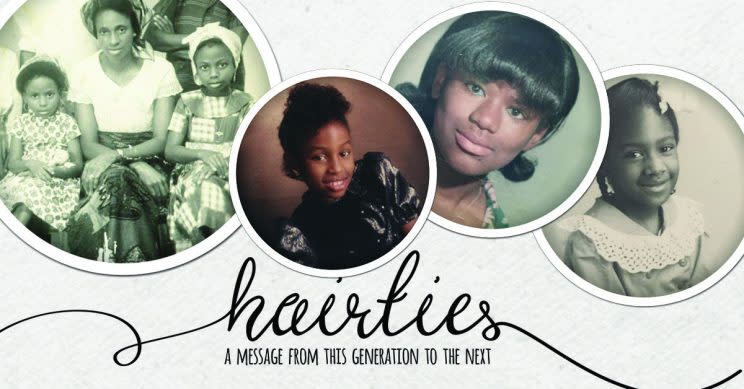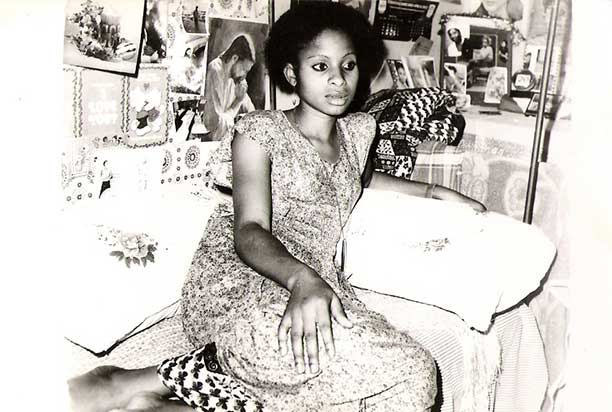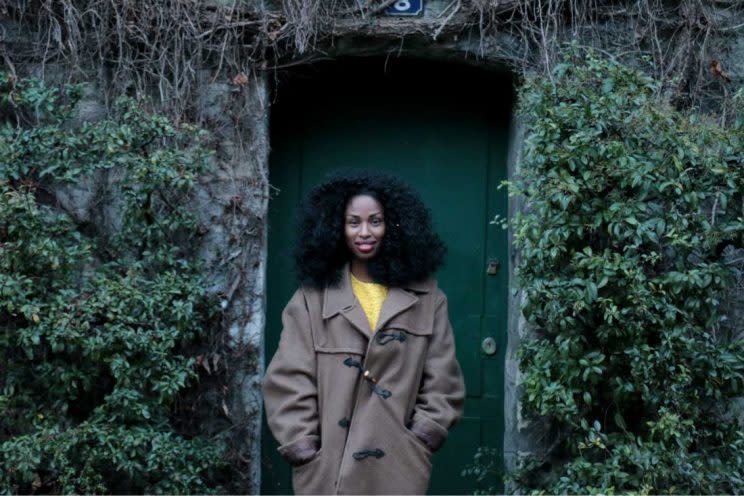#HairTies Video Series Gets to the Root of How Black Women View Their Hair

Antonia Opiah, the founder of hair blog Un-ruly, is no stranger to the politics of black women’s hair. Back in June 2013, she held a public art exhibit in New York City in which three black women with curly, dreadlocked, and straight hair held signs that read, “You can touch my hair.”
This fearless social experiment earned both praise and scrutiny for its raw examination of society’s fascination with black hair. Malliha, one of the participants who sports a big Afro, told the Huffington Post that she was “uncomfortable with the whole issue and finds other people’s curiosity to be highly intrusive.” However, she went through with it hoping to gain insight on why people feel compelled to touch her hair.
Although the public exhibit placed black women (yet again) in a vulnerable position to have their tresses touched by complete strangers, it fueled an ongoing conversation on race and beauty standards. It also inspired Opiah to launch a video series called #HairTies in partnership with hair care brand Smooth ‘N Shine, which “looks back at how our beauty standards were set and what we can say to the next generation in order to change beauty standards.”
Yahoo Beauty caught up with Opiah to learn more about #HairTies, her personal natural hair journey, and how she hopes to shift the norm of what’s considered to be “beautiful” with this video series.
Yahoo Beauty: How did the concept for #HairTies come about?
Opiah: I started thinking about #Hairties a few years ago, after we released our short film, You Can Touch My Hair. In the film, image activist Michaela Angela Davis explains that most black women start off wrong when it comes to their hair, referring to the fact that we’re immediately trying to change our hair because it’s something that’s not considered acceptable or beautiful.
That was certainly the case for me growing up, and I thought: What if that doesn’t have to be the case for the next generation of brown girls? What can we do to start off “right,” to have a whole generation of women loving their hair from the start? And that question led to the conception of #Hairties.

Do you notice and similarities in stories among young and older black women?
One small similarity is that we all start off with braids when we’re little, braids with bows and/or beads. A larger similarity (and I know black women aren’t a monolith, but speaking very generally) and one of the things I love about us is the fact that we love switching up our hairstyles. That’s one of the things I love about the series, seeing each woman’s hair evolution over time.
I also love the fact that across the board, even though all of the women featured no longer relax their hair, they’re not opposed to straight hair. Most advise staying away from caustic chemicals but don’t shy away from straight hairstyles. Shay and myself, for example, are currently rocking straight looks. And I think that’s the beauty of black hair culture and why my site, Un-ruly, exists; we’ve got so many options and our hair is extremely versatile.
How are the perceptions of natural hair different or similar in the U.S., U.K., or in other countries?
From Nigeria to the U.K. to America, kinky hair has been something that people wanted to get rid of by straightening it or covering it up with extensions. America, because of its global media dominance, is at the forefront of the natural hair movement. The stories and images of women rocking their natural hair have spread and continue to spread far.
In your own #Hairties, you discuss “feeling pretty” with a relaxer, or a chemical hair straightener. How did this impact your self-esteem and relationship with other girls and young boys?
There was a direct correlation with my hair being permed and me thinking I looked good and, thus, feeling good about myself. When my hair wasn’t done, or when you’re not feeling yourself, it shows. It shows in your gait, in the way you interact with other people, etc.
And then, of course, there was the fact that kids can be mean and you’d get made fun of if your hair was nappy. I think that’s the thing that seals the deal when it comes to subscribing to a certain standard of beauty.
No matter how much we try not to care what other people say, it’s part of our nature. We’re creatures of communities. What our communities think of us matters. How people respond to you has a greater impact on what you do and believe than the images we might see in the media. The media might say, “this look is beautiful,” but boys liking certain girls because they have that look or girls making fun of other girls who don’t have that look is what’s going to make you believe what the media says.
What has been one of the most profound #Hairties stories you’ve heard so far?
I love all of them, and I think all of them together really make a profound statement on our collective story as women of color, but I will say that I found Marissiko’s story interesting. I think I like her story because her hair type is the type you see more frequently on social media, the softer bouncy curl versus kink. It’s the texture that’s not too far from mainstream beauty standards, so one might think it’s easier to embrace. But it was interesting to hear how she struggled with her texture because being in a family of biracial women, her texture was curlier and not as long as the other girls’. I think that particular part of her experience shows just how relative and subject these standards can be, and also how what you’re surrounded by can impact how you see yourself.
Like many women of all different backgrounds, you’ve experimented with wearing weaves and wigs. Did you find these styles easier or more affordable instead of your natural hair? Or was it tied to self-image and beauty?
Both. I like the way straight or wavy hair looks and I find wigs easier to manage. I stopped wearing wigs for the past couple years and just threw one on about two weeks ago because I’m just too busy right now to do my hair. I’d been neglecting it to the point of it matting (yikes!).
I consulted with one of our at-home hairstylists because I want to start taking better care of my hair. She was very honest with me and explained that I’m not moisturizing enough. But instead of prescribing some outlandish hair regimen, she told me to think of ways I can make moisturizing a part of what I’m already doing. And I think that’s a critical point about any routine or regimen. It has to be tailored to a person’s lifestyle; it has to be achievable for that person.
As such, I’ve decided that protective styles are always going to be a part of my “hair rotation,” but now, unlike before, so is my own natural texture hair. For example, in July, when things slow down a bit, I’m going to go back to braid-outs.

What is your ultimate goal for #HairTies?
My goal is to get as many people to add their voice to the project as possible. People can submit old photos and their message to the next generation. I’m working on creating a final video for that project that will contain as many of those messages as possible. Then hopefully those messages, the videos will be shared as much as possible.
One of the things my marketing experience and Un-ruly has taught me is that repetition is a powerful thing. Norms and standards get set by being stated (in some shape or form) and then repeated over and over again until they’re things we’re all used to and think are a natural part of everyday life. So I want these messages to be stated and repeated over and over again until they go without saying.
Visit the #Hairties pop-up exhibit in New York City on June 24 and June 25 and find out how to add your voice to the series.
This interview has been edited and condensed for clarity.
Read more from Yahoo Beauty + Style:
Follow us on Instagram, Facebook, and Pinterest for nonstop inspiration delivered fresh to your feed, every day. For Twitter updates, follow @YahooStyle and @YahooBeauty.

